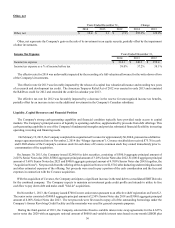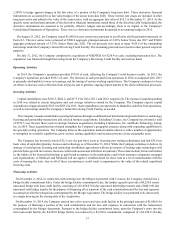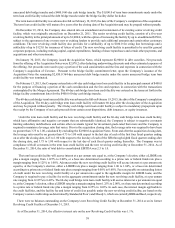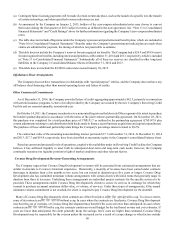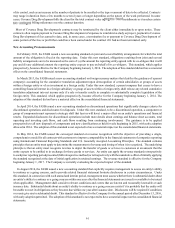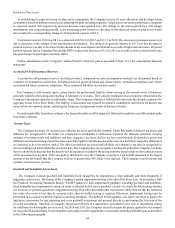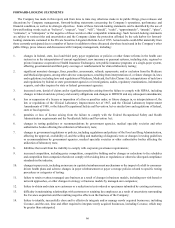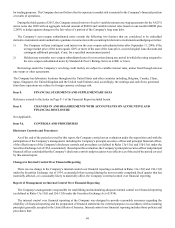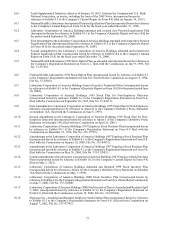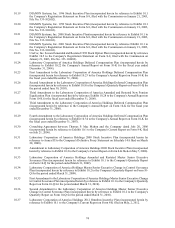LabCorp 2014 Annual Report Download - page 68
Download and view the complete annual report
Please find page 68 of the 2014 LabCorp annual report below. You can navigate through the pages in the report by either clicking on the pages listed below, or by using the keyword search tool below to find specific information within the annual report.66
FORWARD-LOOKING STATEMENTS
The Company has made in this report, and from time to time may otherwise make in its public filings, press releases and
discussions by Company management, forward-looking statements concerning the Company’s operations, performance and
financial condition, as well as its strategic objectives. Some of these forward-looking statements can be identified by the use of
forward-looking words such as “believes”, “expects”, “may”, “will”, “should”, “seeks”, “approximately”, “intends”, “plans”,
“estimates”, or “anticipates” or the negative of those words or other comparable terminology. Such forward-looking statements
are subject to various risks and uncertainties and the Company claims the protection afforded by the safe harbor for forward-
looking statements contained in the Private Securities Litigation Reform Act of 1995. Actual results could differ materially from
those currently anticipated due to a number of factors in addition to those discussed elsewhere herein and in the Company’s other
public filings, press releases and discussions with Company management, including:
1. changes in federal, state, local and third party payer regulations or policies or other future reforms in the health care
system (or in the interpretation of current regulations), new insurance or payment systems, including state, regional or
private insurance cooperatives (Health Insurance Exchanges), new public insurance programs or a single-payer system,
affecting governmental and third-party coverage or reimbursement for clinical laboratory testing;
2. significant monetary damages, fines, penalties, assessments, refunds, repayments, and/or exclusion from the Medicare
and Medicaid programs, among other adverse consequences, resulting from interpretations of, or future changes in, laws
and regulations, including laws and regulations of Medicare, Medicaid, the False Claims Act, interpretations of such laws
and regulations by federal or state government agencies or investigations, audits, regulatory examinations, information
requests, and other inquires by state or federal government agencies;
3. increased costs, denial of claims and/or significant penalties arising from the failure to comply with HIPAA, including
changes to federal and state privacy and security obligations and changes to HITECH and any subsequent amendments;
4. loss or suspension of a license or imposition of a fine or penalties under, or future changes in, or interpretations of, the
law or regulations of the Clinical Laboratory Improvement Act of 1967, and the Clinical Laboratory Improvement
Amendments of 1988, or the federal Occupational Safety and Prevention Act or similar laws and regulations of federal,
state or local agencies;
5. penalties or loss of license arising from the failure to comply with the Federal Occupational Safety and Health
Administration requirements and the Needlestick Safety and Prevention Act;
6. changes in testing guidelines or recommendations by government agencies, medical specialty societies and other
authoritative bodies affecting the utilization of laboratory tests;
7. changes in government regulations or policies, including regulations and policies of the Food and Drug Administration,
affecting the approval, availability of, and the selling and marketing of diagnostic tests or changes in testing guidelines
or recommendations by government agencies, medical specialty societies or other authoritative bodies affecting the
utilization of laboratory tests;
8. liabilities that result from the inability to comply with corporate governance requirements;
9. increased competition, including price competition, competitive bidding and/or changes or reductions to fee schedules
and competition from companies that do not comply with existing laws or regulations or otherwise disregard compliance
standards in the industry;
10. changes in payer mix, including an increase in capitated reimbursement mechanisms or the impact of a shift to consumer-
driven health plans and adverse changes in payer reimbursement or payer coverage policies related to specific testing
procedures or categories of testing;
11. failure to retain or attract managed care business as a result of changes in business models, including new risk based or
network approaches, or other changes in strategy or business models by managed care companies;
12. failure to obtain and retain new customers or a reduction in tests ordered or specimens submitted by existing customers;
13. difficulty in maintaining relationships with customers or retaining key employees as a result of uncertainty surrounding
the Covance acquisition and the resulting negative effects on the business of the Company;
14. failure to identify, successfully close and to effectively integrate and/or manage newly acquired businesses, including
Covance, and the cost, time and effort required to integrate newly acquired businesses, including Covance, which may
be greater than anticipated;


